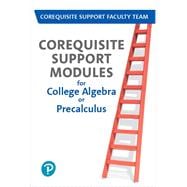For corequisite support courses that accompany College Algebra or Precalculus.
This MyLab Math access card offers 18-week access.
Flexible content, tailor-made for corequisite support courses
Corequisite Support Modules for College Algebra or Precalculus provide targeted developmental review, and can be used in conjunction with any credit-level materials. The Modules include a corequisite support workbook and a corresponding MyLab™ course. The Corequisite Support Faculty Team who created these Modules comprises four instructors with experience in creating content for developmental-level courses, and who have been challenged with implementing corequisite courses at their own institutions.
Instructors can use the Corequisite Support Workbook, the corresponding modular course in MyLab Math, or both. The Modules are an affordable option, ideal for instructors who want to pick and choose review material easily, without requiring students to purchase two full texts or courses.
0135775671 / 9780135775677 MYLAB MATH -- 18 WEEK STANDALONE ACCESS CARD -- FOR COREQUISITE SUPPORT MODULES FOR COLLEGE ALGEBRA OR PRECALCULUS, 1/e








